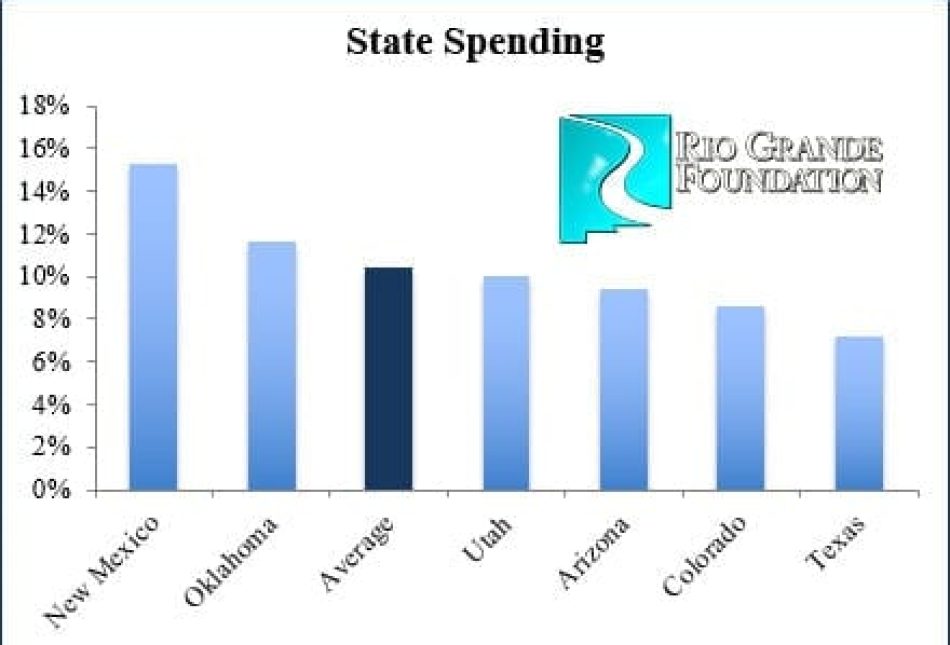Santa Fe New Mexican Column: Before taxes, reform bloated government


The narrative that New Mexico’s government has been “cut to the bone” has taken hold among many in Santa Fe. In a recent news article, Senate Majority Leader Peter Wirth asserted, “The cuts that we have imposed during the 2017 budget year have been devastating.” He went on to say, “I just think the future of our state is really at stake and we’re at a defining moment: Are we just going to obliterate key government functions, including our public schools, or are we going to step up and find measures to bring the revenues in we have to have?”
With all due respect Sen. Wirth, you’re full of it. Despite relatively slow growth in recent years, government at all levels in New Mexico remains far bigger than it is in any of our neighbors or in almost any other state.
The data are plentiful, but let’s start with data from USGovernmentSpending.com. According to the site, state government in New Mexico spends 15.35 percent of overall state gross domestic product. Only Alaska, Hawaii and Vermont outpace us.
Some have asserted that because K-12 education is a state, as opposed to a local, priority, that New Mexico state government seems larger than it really is. Data from the same website show otherwise. In fact, New Mexico moves into third place nationally. Factoring both state and local spending, New Mexico spends 25.03 percent of GDP. This puts us behind only Alaska and Vermont.
By way of comparison with our economically successful neighbors, state and local government in Texas consumes only 15.67 percent of GDP while allegedly “blue state” Colorado spends 18.48 percent.
Despite all of this, we are constantly told (and dozens of bills are introduced) to raise taxes or take money out of the permanent fund. Why
The fact is that New Mexico’s government is bloated and inefficient. Take K-12 education which, according to Wirth, is in danger of being “obliterated.” According to U.S. Census data, our state spends 15 percent of per-pupil spending on administration, and the next-highest state (North Dakota) spends just 9.4 percent. New Mexico spends $11,026 per-pupil on K-12, which is again more than any of our neighbors. Arizona spends $8,786 and Utah spends a paltry $7,714 per pupil, for example.
Yet, on the important fourth-grade reading portion of the National Assessment of Education Progress (the gold-standard test given nationally) New Mexico came in 52nd (dead-last). Even the notoriously bad Washington, D.C., schools outperformed us.
I could go on and on about ways in which New Mexico government underperforms and how it has nothing at all to do with a lack of resources. Why does this situation persist?
The obvious culprit is New Mexico’s lack of something called “economic freedom.” According to the Fraser Institute, a Canadian think thank that studies the issue, economic freedom means: the ability of individuals to act in the economic sphere free of undue restrictions. According to the institute, New Mexico is the 47th-freest U.S. state. In other words, we’re among the least free places in the United States.
This can be overcome by adopting market-based reforms. Unfortunately, unlike in many other economically challenged (but striving to change states), policymakers in New Mexico find it politically rewarding to demand more tax revenue from an already overburdened and relatively small group of businesses and taxpayers as opposed to telling the various interest groups “no.”
Until New Mexicans educate themselves on why economic freedom works and redistribution doesn’t; until they reject the politics and policies of the status quo; and until they organize themselves to force their elected officials to pay attention, New Mexico will remain impoverished with little hope for improvement.
Paul J. Gessing is the president of New Mexico’s Rio Grande Foundation. The Rio Grande Foundation is an independent, nonpartisan, tax-exempt research and educational organization dedicated to promoting prosperity for New Mexico, based on principles of limited government, economic freedom and individual responsibility. He writes the occasional commentary for the newspaper.
